The 10 most popular dwarf cichlid species for an aquarium are Apistogramma agassizii, Apistogramma cacatuoides, Apistogramma borellii, Apistogramma trifasciata, Apistogramma hongsloi, Apistogramma nijsseni, Apistogramma panduro, Apistogramma elizabethae, Apistogramma macmasteri, Apistogramma viejita.
In this article, we will be discussing the 10 most popular dwarf cichlid species and their characteristics, ideal water conditions, compatibility with other fish, and breeding habits. We will also be providing tips on how to set up and maintain a successful aquarium for these species, making it a great resource for those interested in keeping dwarf cichlids.
Table of Contents
What are Dwarf Chichlid Species?
Dwarf cichlid species, also known as Apistogramma, are a popular choice for aquarium enthusiasts due to their vibrant colors and small size. These fish are native to the freshwater rivers and streams of South America and can be found in a variety of different habitats.
Dwarf cichlids are known for their peaceful nature and are suitable for both beginners and experienced aquarists. They are also considered to be hardy and adaptable, making them a great choice for those who want to start their first aquarium.
Types of Dwarf Cichlids
Apistogramma agassizii:
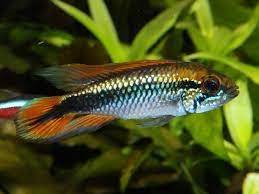
Also known as the “Agassiz’s Dwarf Cichlid,” this species is known for its vibrant colors and hardy nature. They typically have a yellow or orange body with black stripes and a red or orange tail.
- Care: They prefer a pH level of 6.5-7.5 and a water temperature of 72-78 degrees Fahrenheit. They are also sensitive to nitrate levels, so regular water changes are necessary.
- Compatibility: They are peaceful and can be kept with other small, peaceful fish.
- Breeding: They are substrate spawners and prefer a breeding cave or a flower pot to lay their eggs.
- Food: They are opportunistic feeders and will eat a variety of foods, including flake, frozen, and live foods.
Apistogramma cacatuoides:
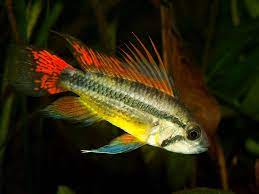
This species, also known as the “Double Full Red” or “Cockatoo Cichlid,” is known for its bright red coloration and long fins.
- Care: They prefer a pH level of 6.0-7.0 and a water temperature of 72-78 degrees Fahrenheit. They are also sensitive to nitrate levels, so regular water changes are necessary.
- Compatibility: They are peaceful and can be kept with other small, peaceful fish.
- Breeding: They are substrate spawners and prefer a breeding cave or a flower pot to lay their eggs.
- Food: They are opportunistic feeders and will eat a variety of foods, including flake, frozen, and live foods.
Apistogramma borellii:
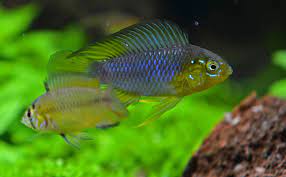
This species, also known as the “Borelli’s Dwarf Cichlid,” is known for its beautiful coloration, including a yellow body with black stripes and a blue-green tail.
- Care: They prefer a pH level of 6.5-7.5 and a water temperature of 72-78 degrees Fahrenheit. They are also sensitive to nitrate levels, so regular water changes are necessary.
- Compatibility: They are peaceful and can be kept with other small, peaceful fish.
- Breeding: They are substrate spawners and prefer a breeding cave or a flower pot to lay their eggs.
- Food: They are opportunistic feeders and will eat a variety of foods, including flake, frozen, and live foods.
Apistogramma trifasciata:
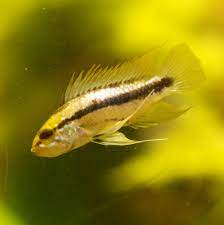
This species, also known as the “Three-stripe Dwarf Cichlid,” is known for its striking coloration, including a yellow body with three black stripes and a red tail.
- Care: They prefer a pH level of 6.0-7.0 and a water temperature of 72-78 degrees Fahrenheit. They are also sensitive to nitrate levels, so regular water changes are necessary.
- Compatibility: They are peaceful and can be kept with other small, peaceful fish.
- Breeding: They are substrate spawners and prefer a breeding cave or a flower pot to lay their eggs.
- Food: They are opportunistic feeders and will eat a variety of foods, including flake, frozen, and live foods.
Apistogramma hongsloi:
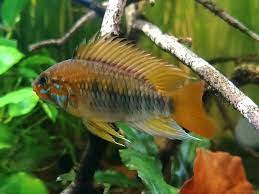
This species, also known as the “Hong’s Dwarf Cichlid,” is known for its bright red coloration and long fins.
- Care: They prefer a pH level of 6.5-7.5 and a water temperature of 72-78 degrees Fahrenheit. They are also sensitive to nitrate levels, so regular water changes are necessary.
- Compatibility: They are peaceful and can be kept with other small, peaceful fish.
- Breeding: They are substrate spawners and prefer a breeding cave or a flower pot to lay their eggs.
- Food: They are opportunistic feeders and will eat a variety of foods, including flake, frozen, and live foods.
Apistogramma nijsseni:
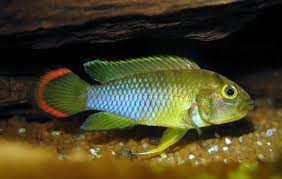
This species, also known as Nijssen’s Dwarf Cichlid, is known for its vibrant orange coloration and its hardy nature.
- Care: They prefer a pH level of 6.5-7.5 and a water temperature of 74-80 degrees Fahrenheit. They are also sensitive to nitrate levels, so regular water changes are necessary.
- Compatibility: They are peaceful and can be kept with other small, peaceful fish.
- Breeding: They are substrate spawners and prefer a breeding cave or a flower pot to lay their eggs.
- Food: They are opportunistic feeders and will eat a variety of foods, including flake, frozen, and live foods.
Apistogramma panduro:
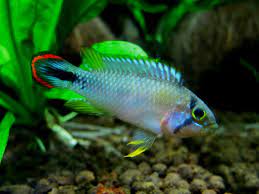
This species is known for its bright yellow coloration and its hardy nature.
- Care: They prefer a pH level of 6.5-7.5 and a water temperature of 72-78 degrees Fahrenheit. They are also sensitive to nitrate levels, so regular water changes are necessary.
- Compatibility: They are peaceful and can be kept with other small, peaceful fish.
- Breeding: They are substrate spawners and prefer a breeding cave or a flower pot to lay their eggs.
- Food: They are opportunistic feeders and will eat a variety of foods, including flake, frozen, and live foods.
Apistogramma elizabethae:
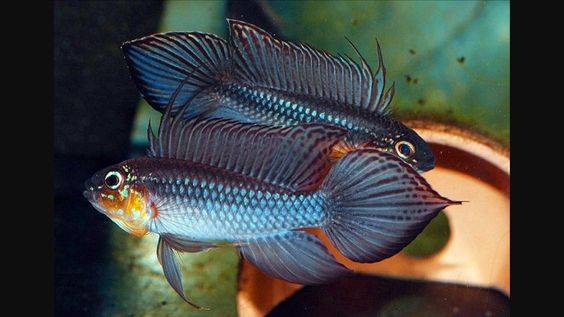
This species, also known as “Elizabeth’s Dwarf Cichlid,” is known for its vibrant orange coloration and its hardy nature.
- Care: They prefer a pH level of 6.5-7.5 and a water temperature of 72-78 degrees Fahrenheit. They are also sensitive to nitrate levels, so regular water changes are necessary.
- Compatibility: They are peaceful and can be kept with other small, peaceful fish.
- Breeding: They are substrate spawners and prefer a breeding cave or a flower pot to lay their eggs.
- Food: They are opportunistic feeders and will eat a variety of foods, including flake, frozen, and live foods.
Apistogramma macmasteri:
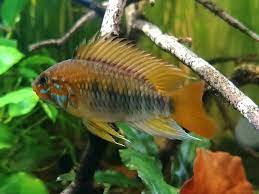
This species, also known as “Macmaster’s Dwarf Cichlid,” is known for its vibrant orange coloration and its hardy nature.
- Care: They prefer a pH level of 6.5-7.5 and a water temperature of 72-78 degrees Fahrenheit. They are also sensitive to nitrate levels, so regular water changes are necessary.
- Compatibility: They are peaceful and can be kept with other small, peaceful fish.
- Breeding: They are substrate spawners and prefer a breeding cave or a flower pot to lay their eggs.
- Food: They are opportunistic feeders and will eat a variety of foods, including flake, frozen, and live foods.
Apistogramma viejita:
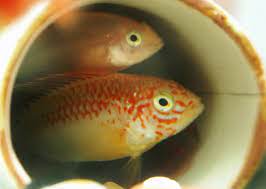
This species, also known as “Viejita’s Dwarf Cichlid,” is known for its vibrant orange coloration and its hardy nature.
- Care: They prefer a pH level of 6.5-7.5 and a water temperature of 72-78 degrees Fahrenheit. They are also sensitive to nitrate levels, so regular water changes are necessary.
- Compatibility: They are peaceful and can be kept with other small, peaceful fish.
- Breeding: They are substrate spawners and prefer a breeding cave or a flower pot to lay their eggs.
- Food: They are opportunistic feeders and will eat a variety of foods, including flake, frozen, and live foods.
It’s worth noting that in order to keep these fish healthy, it’s important to do research on the specific species you’re interested in, as there can be some variations in their care requirements. Additionally, it’s important to keep in mind that these fish are wild-caught and they might require a little bit more attention, care and patience.
Conclusion
- In conclusion, the 10 most popular dwarf cichlid species are Apistogramma agassizii, Apistogramma cacatuoides, Apistogramma borellii, Apistogramma trifasciata, Apistogramma hongsloi, Apistogramma nijsseni, Apistogramma panduro, Apistogramma elizabethae, Apistogramma macmasteri and Apistogramma viejita. These species are known for their vibrant colors and peaceful nature, making them a great choice for aquarium enthusiasts.
- By providing the appropriate water conditions, compatibility and breeding habits, as well as regular water changes, you can set up and maintain a successful aquarium for these species.
- If you’re interested in keeping dwarf cichlids, it’s important to do your research and learn as much as you can about the specific species you’re interested in to ensure that they thrive in your aquarium.
FAQs
What are dwarf cichlids?
Dwarf cichlids, also known as Apistogramma, are a group of small freshwater fish that are native to the rivers and streams of South America. They are known for their vibrant colors and peaceful nature, making them a popular choice for aquarium enthusiasts.
How big do dwarf cichlids get?
Dwarf cichlids typically reach a maximum size of around 2-3 inches in length.
Are dwarf cichlids suitable for beginners?
Yes, dwarf cichlids are considered to be hardy and adaptable, making them a great choice for beginners.
What kind of tank setup do dwarf cichlids need?
Dwarf cichlids need a tank with a pH level of 6.5-7.5 and a water temperature of 72-78 degrees Fahrenheit. They also prefer a tank with plenty of hiding places, such as caves or plants.
Can dwarf cichlids be kept with other fish?
Yes, dwarf cichlids are peaceful and can be kept with other small, peaceful fish.
How often do I need to do water changes for dwarf cichlids?
Dwarf cichlids are sensitive to nitrate levels, so regular water changes are necessary to keep them healthy. It’s recommended to do a water change of at least 25-50% once a week.
What do dwarf cichlids eat?
Dwarf cichlids are opportunistic feeders and will eat a variety of foods, including flake, frozen, and live foods.
How do I breed dwarf cichlids?
Dwarf cichlids are substrate spawners and prefer a breeding cave or a flower pot to lay their eggs. It’s important to provide them with the appropriate water conditions and to separate the male and female fish before breeding.
How can I tell if my dwarf cichlid is a male or female?
In most species, males will be larger and have more colorful fins and markings than females.
Can I keep more than one male dwarf cichlid in the same tank?
It is not recommended to keep more than one male dwarf cichlid in the same tank as they may become territorial and aggressive towards each other.
Can I keep dwarf cichlids with other species of cichlid?
It’s not recommended to keep dwarf cichlids with larger cichlid species as they may become aggressive towards the smaller fish.
What kind of filtration do dwarf cichlids need?
Dwarf cichlids need a good filtration system that can handle the water flow and keep the water clean. A hang-on-back or canister filter would work well.
Can I keep dwarf cichlids in a community tank?
Dwarf cichlids can be kept in a community tank with other small, peaceful fish.
How long do dwarf cichlids live for?
Dwarf cichlids typically live for 3-5 years.
Do dwarf cichlids require a specific type of substrate?
Dwarf cichlids do not require a specific type of substrate, but a fine gravel or sand substrate would work well.
You may also be interested in other articles, please check out The 10 best schooling fish for a visually stunning freshwater tank
References
The International Discus Association (IDA)
The South American Cichlid Association (SACA)
The American Cichlid Association (ACA)
I am a passionate aquarist with over 30 years of hands-on experience in fishkeeping. My journey began at a young age, collecting fish from the wild and learning through experimentation. Specializing in tropical fish, I bring a deep understanding of the hobby to FishKeepingMadeSimple. The site provides honest, detailed reviews of essential products and accessories to help fellow enthusiasts create the best environments for their fish.

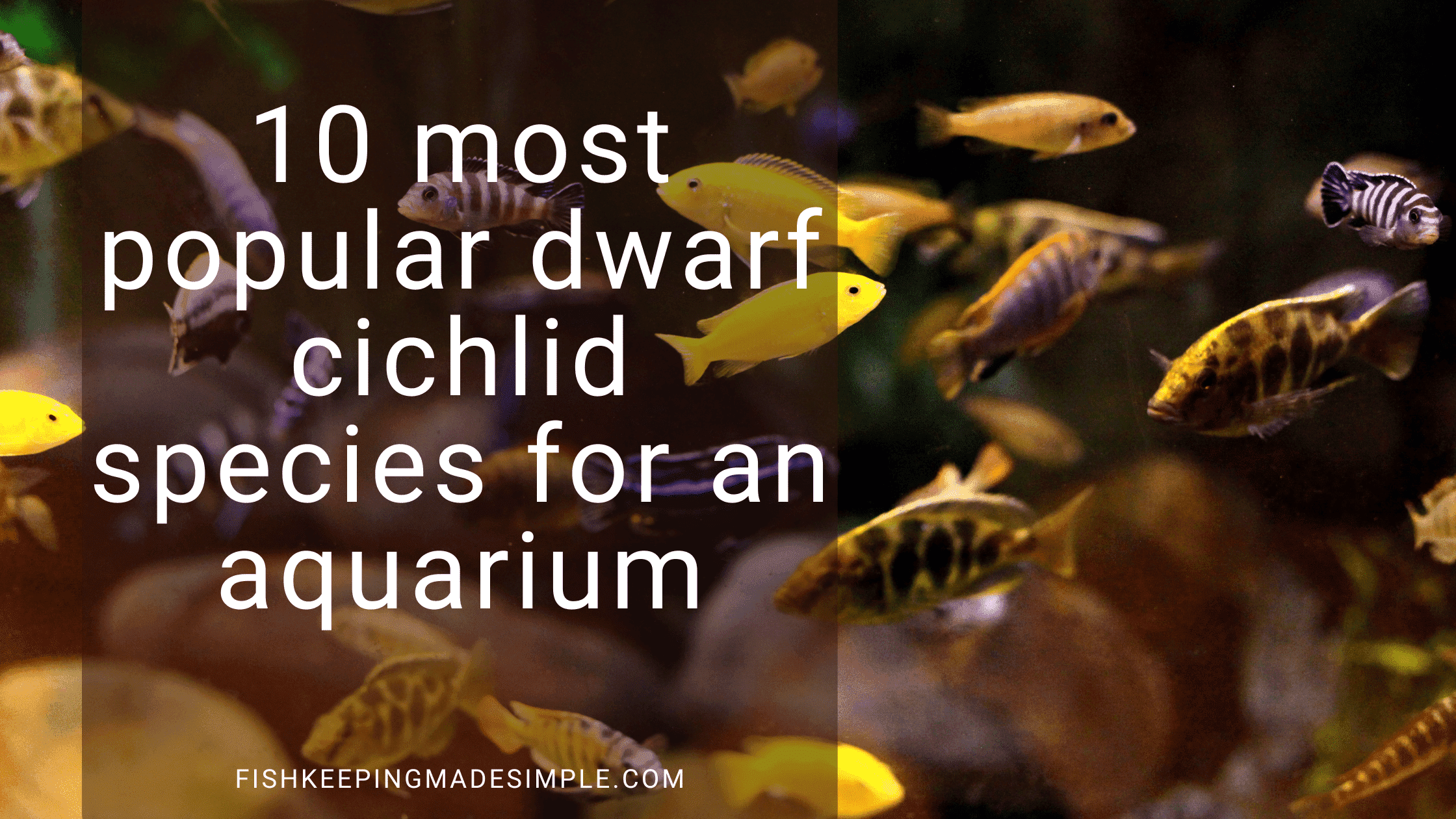








[…] Cichlid Species […]
[…] tetras generally get along well with other tetras, rasboras, danios, corydoras, and some dwarf cichlids. In terms of size, white tetras can vary, but typically they grow to a moderate […]
[…] the Blue Bumblebee Cichlid is a fantastic addition to any freshwater aquarium, bringing beauty, personality, and excitement to your aquatic […]
[…] these magnificent fish. Gouramis are a type of freshwater fish native to Southeast Asia and are a popular choice among aquarium enthusiasts due to their unique appearance and calm […]
[…] yellow, and red make them pop in any tank. They’re peaceful fish, unlike some aggressive Cichlids. This makes them perfect friends for many types of […]
[…] same size as the rams. Consider tetras, Sterbai cory catfish, plecos, discus, angelfish, and other dwarf cichlids. They tolerate warm water and help prevent space conflicts. This ensures a peaceful […]
[…] The 10 most popular dwarf cichlid species for an aquarium – fishkeepingmadesimple.com […]
[…] Dwarf Hairgrass (Eleocharis parvula): This popular dwarf grass variety forms a lush carpet-like appearance in your aquarium. Its thin, needle-like blades create a vibrant and natural look. Dwarf hairgrass is known for its low-maintenance nature and its ability to tolerate a wide range of water conditions. It is a slow-growing plant that requires good lighting and nutrient-rich substrate to thrive. […]
[…] Most cichlid species are known for their aggression and territorial behavior, which can stress out the peaceful Dwarf […]